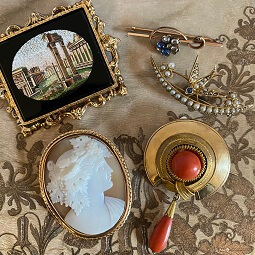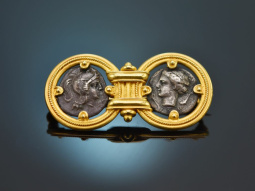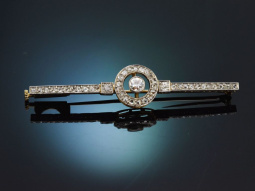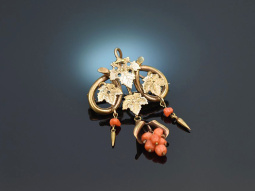Antique Brooches
(until around 1930)
Brooches were originally used as garment clasps and were primarily intended to hold clothing together. As fibulae, this type of jewellery was widespread until the High Middle Ages and only developed into a purely decorative object from the 16th century onwards, which we know today as a brooch. Find out more »
Antique brooches combined in a modern way

With an antique brooch, you can show off your individuality and create a look that stands out from the crowd. The brooch does not have to be traditionally placed on the lapel: feel free to attach your antique companion to a hat or scarf, on the shoulder of a dress or in the centre of the button placket of your blouse.
Antique brooches over the course of time
Classicism
Classicism favoured cameo brooches that were decorated with motifs from antiquity. Roman or Greek vedutas, mythological figures and deities were masterfully realised in the smallest of spaces and found among other motifs such as flowers, animals and birds. The micromosaic is also frequently found on antique classical brooches and is highly valued today as a miniature work of art.
Biedermeier
Biedermeier brooches were often made of foam gold and were quite opulent.
Historism and Belle Époque
Historism, with its reference to the art of the past, gave rise to varied jewellery designs, which - depending on the style - could be very different. For example, there are Neo-Renaissance brooches in colourful enamel, asymmetrical and figurative designs alongside well-ordered and strictly structured Neoclassical models. Entire sets were often produced - so-called parures - so that brooches matched earrings and necklaces, creating a harmonious whole.
At the beginning of the 20th century, the Belle Époque produced airy, delicate brooches that were reminiscent of fine lace thanks to their predominantly light-coloured materials such as platinum, silver and diamonds and symbolised the lightness of that time in their shapes and motifs.
Art Nouveau
In Art Nouveau, forms inspired by nature came to the fore. In contrast to the later Art Déco, no specific metal was favoured during this period: jewellery pieces were made of gold doublé, silver and yellow gold in equal measure. However, an outstanding stylistic element of antique Art Nouveau brooches was the so-called window enamel (plique-à-jour), with which translucent panels could be created that looked like beautiful coloured glass windows.

Art Déco
Antique brooches of the Art Déco were strongly influenced by the futuristic-geometric tendencies of the visual arts, which often resulted in angular, architectural designs. Brooches in the shape of a circle or polygon were often designed with an open centre and decorated on the sides with symmetrical and diamond-studded decorative elements. Another classic of the early 20th century was the Art Déco bar brooch.
Antique brooches and more at Halsbandaffaire in Munich
At Halsbandaffaire you will always find high-quality antique jewellery that can be combined for numerous occasions or given as a wonderful gift. With antique necklaces and the matching antique earrings you will receive authentic historical and unique pieces that are also very beautiful with a corresponding antique ring or an antique bracelet.
Let our experts advise you on site and find your new favourite piece of jewellery with us!











































